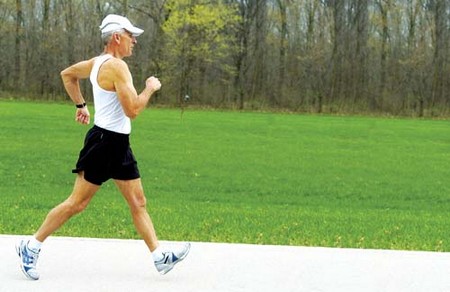The following injuries are the most common to walkers and joggers.
Achilles Tendon Injuries
The achilles tendon connects the calf muscle to the heel of the foot. Achilles tendonitis is a painful inflammation often accompanied by swelling. The three most frequent causes of achilles tendonitis are jogging uphill, wearing walking or jogging shoes with inflexible soles, and failing to maintain a stretching program. Symptoms include burning pain, which usually appears early in the workout and then subsides until the exercise ends, at which time the pain reappears and progressively worsens.
Treatment includes icing the tendon, followed by gently stretching. Prevention involves daily stretching to increase flexibility of the calf and the use of quality walking or jogging shoes. Preventive maintenance is important because the tendon can tear or rupture under stress. In the latter case, surgery becomes the only effective treatment, but either situation leads to a long period of inactivity. You may consult this podiatrist near me Huntington NY for expert services.
Blisters
Blisters are painful friction burns of a minor nature that result in fluid-filled sacs of various sizes. Blisters can be prevented by wearing properly fitted shoes and clean socks and using the correct footstrike. In addition, foot or talcum powder may be sprinkled inside socks and shoes to reduce friction.
Moleskin (toughskin) can be applied to areas of the feet that tend to blister. These “hot spots” are reddened areas that will become blisters quickly if preventive measures are not taken. If a blister forms:
1. Wash the area thoroughly with soap and water.
2. Apply a generous coat of iodine to the blister and the surrounding area.
3. With a sterile needle, puncture the blister at its base, and squeeze out the accumulated fluid.
4. Apply an antiseptic medication and a sterile dressing.
5. Continue exercise after treatment by cutting a “doughnut” from foam rubber and taping it over the blister.
Chafing
Chafing occurs in areas that are subject to a lot of friction. For example, people with large thighs that rub together often experience chafing. This minor but aggravating injury can be prevented easily by applying a generous coat of vaseline to susceptible areas prior to the workout. Treatment for chafing is to immediately cease walking and jogging with the onset of irritation, and to apply an antiseptic lotion.
Chondromalacia Patella
Chondromalacia patella (chondro = cartilage; malacia = softening; patella = kneecap) is commonly referred to as “runner’s knee.” This describes a condition in which the kneecap tracks laterally rather than vertically during flexion and extension of the leg. Typical symptoms are soreness around and under the kneecap, particularly when jogging uphill or climbing stairs. The pain must be eliminated before resuming jogging safely.
Treatment includes resting, applying ice, and taking aspirin every 4 hours for several weeks. Ice treatment should be discontinued after 24 to 36 hours and replaced with moist heat application several times per day as long as needed.
When pain abates, the jogger can begin progressive resistance exercises to strengthen the quadriceps group (the large muscles in the front of the thigh) and a low-intensity, graduated jogging program. Preventive measures include:
1. Using orthotics (supports placed in jogging shoes to compensate for biomechanical problems); these are designed to prevent abnormal motions in the foot and lower leg during jogging
2. Avoiding hard running surfaces such as concrete sidewalks
3. Abstaining from sloped or hilly terrain
4. Keeping stair-climbing to a minimum.
